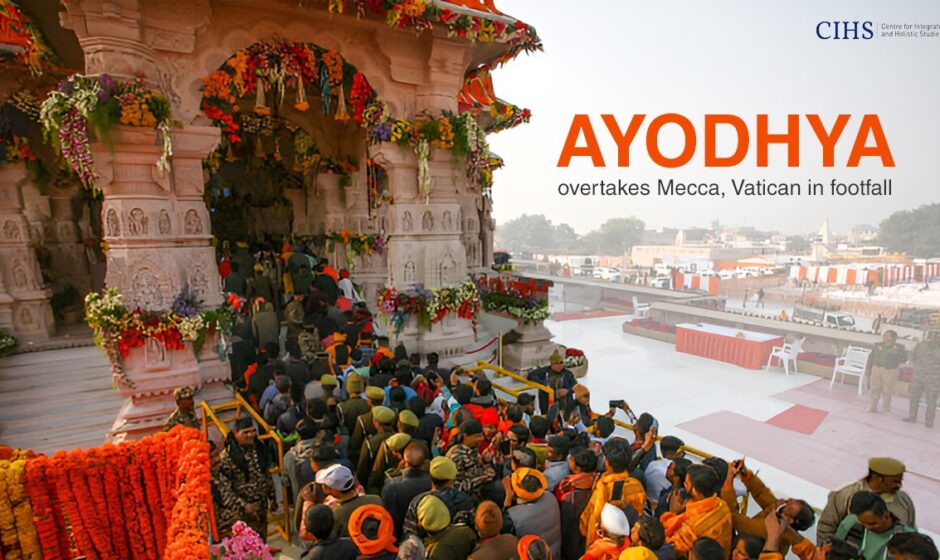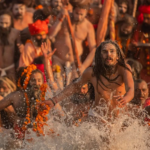One Year after Bhagwan Ram Lalla’s Pran Pratishta, the holy town holds out hope to be fulcrum of Hindu renaissance.
Pummy Pandita
Bhagwan Ram’s Pran Pratishta in January 2024 at his very birthplace in Ayodhya marked a new chapter in cultural and spiritual journey of Bharat.

Since the construction of magnificent temple as abode of Ram Lalla, Ayodhya has undergone a transformation that devout Hindus connect to in spiritual terms and practicing faith.
There’s no denying that Ayodhya, once a neglected, haunted and disconnected small town, is not any of these anymore. It’s bustling with devout people converging to Ayodhya by road, airways and superfast trains’ network.
Infrastructure in Ayodhya has also undergone a sea change with roads, waterways and huge tourism circuit with hospitality points coming up in last one year.
Footfall in Ayodhya as per estimates has crossed that of Vatican (6.7 Mn in 2023) and Mecca (1.83 Mn in 2024) many times over.
As per Hindu calendar, January 11, 2025 marks first anniversary of Prana Pratishtha of Bhagwan Ram Lalla and the day would be celebrated as “Pratishtha Dwadashi” at Shri Ram Janmabhoomi Mandir in Ayodhya. A clutch of religious rites, devotional recitations, cultural acts and spiritual talks will be performed at the sanctum sanctorum and the entire Ayodhya Dham. Over three crore people are expected to witness the grand celebrations of Shri Ram’s Pran Pratishtha anniversary.
Spiritual ceremonies will be held at Yajna Mandap, a dedicated location within the Mandir premises at break of dawn to kick off the celebrations. The Agnihotra ceremony involving lighting of fire will take place during 8 am – 11 am and again between 2 pm to 5 pm. This age-old Vedic practice is known for spiritual and cleansing and is carried out using mantras from Sukla Yajurveda. In addition to purifying the area, the ceremony will aid in fostering a spiritually uplifting atmosphere for the day’s activities.
Highlights of the Day:
- Agnihotra rituals (8:00 AM–11:00 AM & 2:00 PM–5:00 PM) at Yajna Mandap, fostering purification and spiritual upliftment.
- Raga Seva (3:00 PM–5:00 PM): A classical music concert on the Mandir’s ground floor.
- Badhai Gaan (6:00 PM–9:00 PM): Joyful musical tributes celebrating Bhagwan Ram.
- Ramcharit manas Recitation at Yatri Suvidha Kendra: Melodic retelling of Bhagwan Ram’s divine story.
- Narratives/Discourses and Cultural Performances:
- Ram Katha (2:00 PM–3:30 PM) and Ramcharit manas Analysis (3:30 PM–5:00 PM) at Angad Teela sharing timeless lessons from Bhagwan Ram’s life.
- Traditional dances and art celebrating Bharat’s vibrant heritage (5:30 PM–7:30 PM) at Angad Teela.
Shri Ram’s Prasad, that’s regarded as a celestial blessing, will be offered all day long to devotees from early morning hours reflecting Bhagwan Ram’s grace.
A Year of Record-breaking Footfall
Shri Ram Lalla’s Pran Pratishtha has turned Ayodhya into a popular pilgrimage centre. An unprecedented 15 million pilgrims are estimated to have visited Shri Ram Mandir to seek the blessings of Shri Ram Lalla. Temple’s tremendous appeal was highlighted by daily footfall exceeding two lakh people daily during peak seasons like Ram Navami and Deepawali. Due to this massive influx of visitors, Ayodhya is now on par with Varanasi and Tirupati as one of India’s most popular pilgrimage destinations and overtaken both Mecca and Vatican, the two religious centres for faithful Muslims and catholic Christians respectively.
Wider road networks, better train connectivity and recently opened Ayodhya International Airport have contributed to the boom in tourism. These advancements have made it easier for pilgrims from all over Bharat and the world to travel to Ayodhya.
Economic Windfall
Ayodhya has experienced exceptional economic growth due to constant influx of devotees. As per local authorities, the city’s yearly income from tourism-related activities has more than doubled hitting almost ₹4000 crore (approximately half a billion US dollars) in the most recent year – the key contributors included pilgrims’ arrival that has brought in about ₹15,000 crore ($1.8 billion) in tourism-related income. Occupancy rates at local establishments, such as restaurants, motels and guesthouses have increased significantly, surpassing 90 per cent during busy times.
- Hospitality Industry: To accommodate pilgrims with a range of budgets, more than 500 new hotels, dharamshalas and guest homes have opened. These establishments have continuously had occupancy rates above 85 per cent particularly during festival days.
- Retail and Handicrafts: Traditional handicrafts, religious arte facts and souvenirs are in high demand. Due to consumer desire for locally produced goods viz., traditional handicrafts, religious artefacts, and souvenirs which are in high demand, artisans and traders have reported a 70 per cent rise in sales.
- Transport Services: Demand for local transport services such as rental cars, e-rickshaws and auto-rickshaws have increased by 60 per cent.
- Food and Beverages: Local restaurants’ business has grown considerably with many establishments now serving saatvik (pure vegetarian) food that is catered to pilgrims’ tastes.
- Cultural Events and Festivals: Ayodhya’s celebration of festivals like Ram Navami and Deepawali has grown in size in Ayodhya attracting global attention. These festivities have raised the city’s status internationally by drawing sponsorships and foreign visitors.
Infrastructure Development
Realizing Ayodhya’s potential to into a world hub of spirituality, Uttar Pradesh state and Bharat’s central governments has made significant infrastructure investments:
- Ayodhya International Airport: Has handled over one million passengers in its first year of operations since mid-2023.
- Ram Path and Riverfront Development: Ayodhya city’s aesthetic and functional appeal have enhanced with beautification projects along Sarayu River and construction of Ram Path.
- Smart City Initiatives: Overall pilgrims’ experience has been elevated with installation of modern amenities viz., Wi-Fi zones, LED lighting and advanced waste management systems.
Spiritual and Cultural Renaissance
Ram Lalla’s return to his abode and birthplace has ignited a cultural revival in Ayodhya. The city is now a thriving centre of faith based activity thanks to regular kirtans, bhajans and spiritual talks. To raise awareness of Shri Ram’s teachings, temple administration has planned a number of events that draw both young people and academics.
Shri Ram Lalla’s return to Ayodhya also represents a cultural revival. It has inspired a generation to reconnect with their heritage and rekindled interest in Bharat’s legendary stories. The temple’s exquisite carvings and imposing construction serve as a tribute to the magnificence of traditional Indian craftsmanship.
In addition to revitalising millions of people’s spiritual ties, Shri Ram Lalla’s Pran Pratishtha has transformed Ayodhya into a centre for both cultural and economic renaissance. Ayodhya is a living example of transformational power of Hindu faith as the city continues to change, striking a balance between its rich legacy and contemporary goals.
While the first year of Shri Ram’s homecoming is significant, this holy place is expected to make even more waves in years to come.
(Author is head of operations at Centre for Integrated and Holistic Studies, a non-partisan think tank based in New Delhi)Ayodhya Overtakes Mecca, Vatican in Footfall



